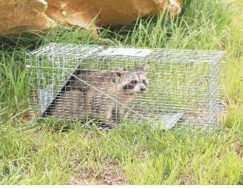Homeowners frustrated by the damage done by raccoons may entertain thoughts of getting rid of raccoons with firearms, cyanide, flamethrowers, and bazookas. None of the most cost-effective means of getting rid of outdoor raccoons, however, involves killing them. Outdoor raccoons are best controlled and later gotten rid of through a combination of detection, habitat modification, exclusion, frightening, and trapping followed by removal i.e. using humane methods.
Detecting Raccoons

Not many animals can do as much damage to gardens overnight as raccoons. Entire vegetable crops may be decimated, especially tomatoes as they approach their peak of ripeness and corn on the cob as it reaches its super-sweet milky stage. Raccoons can kill song birds and pet chickens, and they can frighten dogs and cats. They make an unmistakeable rustle when they colonize the attic. Making sure that the pest is a raccoon, however, requires two basic detective skills.
Raccoons leave tracks. Their tracks are remarkably similar to a small human hand print. There are four thin fingers and a “thumb.” Both porcupines and skunks also have “five-fingered” paw prints, but a raccoon track bears the closest resemblance to the imprint of a human hand.
Raccoons also leave scat, feces deposited randomly on the landscape. Raccoon droppings have blunt ends and are of uniform thickness. It is usually dark and contains vegetable matter such as leaves, partially digested berries, and kernels of corn. Unlike the droppings of strictly carnivorous animals such as foxes, it usually does not contain hair.
Habitat Modification
The first step in getting rid of raccoons naturally is making your house, lawn, or garden a less desirable location for them. According to the ICWDM, priority should be given to securing trash cans. Sturdy rubber or plastic trash cans are best, such as the Rubbermaid Commercial Brute Rollout Container, Square, Plastic, 50 Gallons, Gray (9W27GY). Smaller trash cans should be placed on a rack elevated at least one foot (30 cm) off the ground. All outdoor refuse receptacles must have tightly fitted lids that are kept closed at night.
Pet food is gourmet food for raccoons. If you have outdoor pets, take their food inside at night. If you live in a dry climate or there is a drought, take water bowls inside, too. Pick up fallen nuts and fruit, and harvest vegetables as they ripen. Do not leave tasty morsels on which raccoons will dine.
Raccoons prefer wooded habitats that give them cover. Keeping your lawn mowed and making sure you have a separation between flower beds and shrubs will help keep raccoons at bay. Take down any trees limbs within 5 feet (1.5 meters) of your roof to keep raccoons from leaping inside, and make sure everyone in your household makes a habit of closing the door as they come in.
Exclusion

Ordinary fences are not very effective for controlling raccoon traffic. Raccoons simply climb over or dig under them. Electric fences, however, are an effective barrier to raccoons and squirrels. Electric fences properly charged will not hurt animals or people. The power source for an electric fence is usually either a solar panel (Fi-Shock SS-440 Solar-Powered Low Impedance 10 Acre Medium-Duty Electric Fence Charger) hooked to a battery, since the fence has to be operative at night when raccoons are active, or a step-down transformer attached to household current (such as the Fi-Shock SS-725CS AC Powered Light-Duty Electric Fence Charger, 5-Acre Range). Never connect an electric fence directly into household current. String one line on insulators placed 6 inches (15 cm) above the ground and a second line 12 inches (30 cm) above the ground. Because hair provides insulation, a rapidly moving raccoon will not be shocked by an electric fence unless it encounters a barrier it cannot go over or under.
Keep raccoons out of crawl spaces underneath decks, porches, or pier and beam flooring by installing 1/2 to 3/4 inch (15 to 23 mm) mesh (such as G & B 309301A 24-Inch x 25-Foot 1/2-Inch Galvanized Mesh Welded Mesh Fence) completely across the open space and dug 6 inches (15 cm) into the ground. Raccoons can dig under mesh wire lying on the surface of the ground. Make sure chimneys are capped with a spark arrester that allows smoke to pass through but keeps raccoons out. Reinforce weak fascia boards, shingles, and eaves.
Frightening Raccoons
Like most woodland creatures, raccoons conserve energy by avoiding confrontation. At least for a few days, they can be deterred by the scent of bloodmeal (such as Miracle-Gro 100961 Organic Choice Blood Meal, 3-Pound) or bonemeal (Miracle-Gro 100940 Organic Choice Bone Meal, 3-Pound, either product available from Amazon at a very low cost for Amazon Prime members) placed around plants. The bloodmeal or bonemeal will do double duty as a natural fertilizer. Raccoons can also be temporarily deterred by motion activated strobe lights or radios playing intermittently. If the same frightening method is used for more than a few days, raccoons will learn to ignore it.
Raccoons can also be deterred by placing fox urine granules (Shake Away 3004503 Small Animal Repellent – Fox Urine Granules, 3 lbs.) along the perimeter of your property, but the granules have to be replaced every time it rains. After a week or so, especially if food supplies are short, raccoons may boldly venture in despite the placement of predator urine.
Trapping Raccoons for Relocation

There are many simple humane traps that catch raccoons. The least expensive models consist of a cylindrical pipe with a cuff that is staked to the ground. The raccoon inserts its paw to obtain the bait inside, and is trapped. The trapper comes by later to kill the raccoon, if it has not died of thirst or starvation and it has not been killed by predators. Cuff traps easily trap household cats, which would also need to be euthanized, and sometimes trap dogs.
The Havahart traps are a humane alternative to traditional trapping. For raccoons, the best trap is of sufficient size to contain the catch (preferably 15 x 15 x 32 inches or 38 x 38 x 80 cm). Raccoon traps should have only one door rather than two, to avoid the possibility of trapping a stronger raccoon with a weaker house pet. Once caught, the raccoon can be transported, cage and all, to an animal sanctuary at least 6 miles (10 km) away from the trapping site for release into the wild without injury.
There are many methods of killing raccoons. Most of them are illegal. Most of the pose a risk to lives of pets and the well being of children. Using a combination of detection, habitat modification, exclusion, frightening, trapping, and removal enables getting rid of raccoons naturally.

“the trapper comes by later to kill the racoon, if it has not died of thirst or starvation”!!!
Horrible!! this is not humane.
Hi Susanna – what do you suggest is a humane solution?
We have a terrible problem with raccoons in our porch roof. They are eating all of our flowers from the garden beds and noisy in the porch roof. We have tried putting barriers up to keep they away without luck. I am going to show my husband these helpful tips. I hope they work. Thank you.